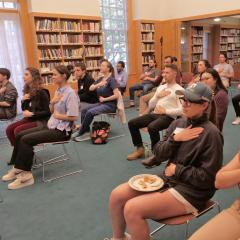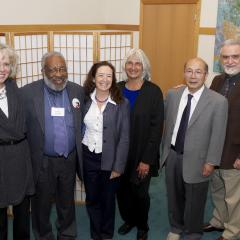Yoichi Kawada Explains the Buddhist Outlook on Life and Death
This article by Helen Marie Casey summarizes key ideas from Yoichi Kawada’s 2001 talk at the Center, “The Buddhist Outlook on Life and Death.”
*
Yoichi Kawada, director of the Institute of Oriental Philosophy in Tokyo, Japan, visited Cambridge to discuss the Buddhist understanding of life and death. First trained as a physician, the Buddhist teacher has written extensively on Buddhism and medical science. With a focus in his remarks on the Mahayana Buddhist tradition, Dr. Kawada elaborated on the fundamental concepts that unite Buddhists, beginning with the belief that all living beings go through cycles of life and death, and their movement through these cycles is controlled by the power of karma.
“Buddhism,” he explained, “denies a fixed identity of self, such as a soul. Buddhism also denies,” he continued, “a nihilistic view that after death nothing remains.”
Yoichi Kawada summarized the early Buddhist scriptures this way: “They speak of death as the process in which consciousness is lost, the body loses its warmth, and then finally one can say that that person’s life span has expired. This is how they understood death.”
Within the Mahayana tradition, there is the concept of consciousness, that stage in which we are awake and conscious, deriving information from our senses. Mano consciousness is the next layer, when consciousness functions independent of the senses (mano consciousness can be considered a form of unconsciousness or subconsciousness). Then there is alaya consciousness, an even deeper layer. “This is where consciousness resides and continues during death,” Dr. Kawada observed. “If we were to find a parallel, it would be between the alaya consciousness and the Jungian idea of the collective unconscious.”
Clarifying some misconceptions, the Buddhist scholar continued, “When Buddhism speaks about denying the self, it is denying that this conscious self is our real or our true self.” Further, he elaborated, “Buddhism sees the seeds for both our delusions and our positive impulses within the alaya consciousness in the form of a latent energy, which can also be referred to as “karma.”
The concept of dependent origination, the lecturer observed, “refers to the interconnectedness of all things. The first interconnection that it points to is this relationship between the alaya consciousness and the other layers of consciousness. Another connectedness in the alaya consciousness is over the time scale. At each moment we have new experiences, creating new karma, and that is connected over time as each moment each karmic experience gives birth to the next. This is what creates the continuous flow of karmic energy. In terms of space, interconnectedness or dependent origination of the alaya consciousness refers to the way our alaya consciousness interacts with the alaya consciousness of other people around us.”
Dr. Kawada suggested that a fear of death is based on a fear that the alaya consciousness is going to disappear— which it is not—and that we will become extinct. He went on to explain to the guests who had assembled to hear him that “Buddhism posits an even more fundamental consciousness that supports the functioning of all individuals’ alaya consciousness. That is the ninth consciousness, which can be thought of as the universal life consciousness of the cosmos itself. This is something that can also be referred to as the fundamentally pure or unstained consciousness.”
Through experiencing the unstained consciousness, we can transform karma from negative to positive and, Dr. Kawada elucidated, “all of that good karma is also what is passed on after the moment of death and will then become manifest again as an individuated human being in the future when the conditions are right. An alaya consciousness filled with positive karma is another way of saying a Buddha.”
As he moved toward the conclusion of his remarks, Yoichi Kawada described the state toward which Buddhists aspire: “Within the alaya consciousness emerges a wisdom which is sometimes referred to as the great mirror of wisdom. This is the wisdom to be able to perceive all things exactly as they are. The wisdom that arises in the mano consciousness is referred to as nondiscriminating wisdom. This is the wisdom to be able to see and perceive the fundamental equality of all living beings and to deal with them on an equal and unchanging basis of respect.”
Conflicts can be overcome, including conflicts among ethnic and racial groups and environmental threats, if we tap into these kinds of sources of wisdom, Dr. Kawada summarized.


